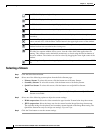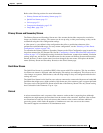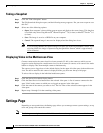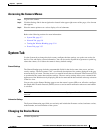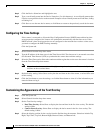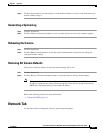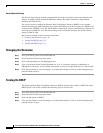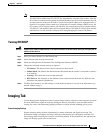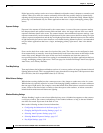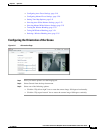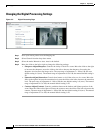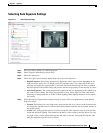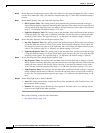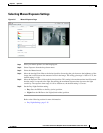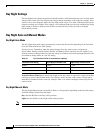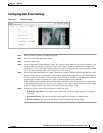
3-12
Cisco Video Surveillance 5010/5011 Indoor Fixed HD IP Dome Camera User Guide
OL-22669-02
Chapter 3 Operation
Imaging Tab
Digital processing settings can be set to Auto or Manual to adjust the camera’s sharpness, saturation, and
contrast. When set to Auto, the camera continually delivers the best possible image by automatically
adjusting the digital processing settings based on the scene. Auto is the default setting. Manual digital
processing is recommended only for indoor applications that have a single, unchanging primary light
source.
Exposure Settings
Exposure is the amount of light detected by the camera sensor. A scene with correct exposure settings
has adequate detail and contrast between white and dark values. An image with too little or too much
exposure eliminates detail in the scene. The camera features Auto and Manual exposure settings. Auto
exposure automatically sets the amount of light detected by the camera sensor based on settings for light
control, exposure compensation, and the day and night exposure times. Manual exposure sets the amount
of light detected by the camera sensor based on a user-defined setting. Manual exposure is recommended
only for indoor applications that have a single, unchanging primary light source. Auto is the default
setting.
Focus Settings
Focus sets the back focus to the center focal point of the scene. The camera can be configured to back
focus automatically or manually. Auto focus automatically back focuses the camera on the subject in the
center of the scene. Manual focus turns off the auto focus mechanism and locks the camera at a
user-specified position. The manual focus setting is recommended only for indoor applications that have
a single, unchanging primary light source. The Focus page also includes Full Range Auto-Focus, Quick
Auto-Focus, and a Factory Defaults.
Tone Map Settings
Tone map balances the brightest and darkest sections of a scene to produce an image with more balanced
lighting and more detail. This is accomplished, in part, when the device maps the 10-bit input sensor data
(0 to 1023 bits) into 8-bit output RGB values (0 to 255 bits).
White Balance Settings
White balance settings define how the camera processes video images to render true colors in a scene.
White balance is especially effective in scenes with changing lighting conditions or in scenes with more
than one type of light source. For example, scenes that benefit from white balance correction are outdoor
scenes, indoor scenes that include a window or door that opens to the outdoors, or indoor scenes that
include both incandescent and fluorescent lighting.
Window Blanking Settings
Window blanking is used to conceal user-defined privacy areas. A blanked area appears on the screen as
a solid gray window. The camera can handle up to four blanked windows as long as the total blanked
area does not exceed 50 percent of the field of view.
Refer to the following sections for more information:
• Configuring the Orientation of the Scene, page 3-13
• Changing the Digital Processing Settings, page 3-14
• Selecting Auto Exposure Settings, page 3-15
• Selecting Manual Exposure Settings, page 3-17
• Day Night Settings, page 3-18



